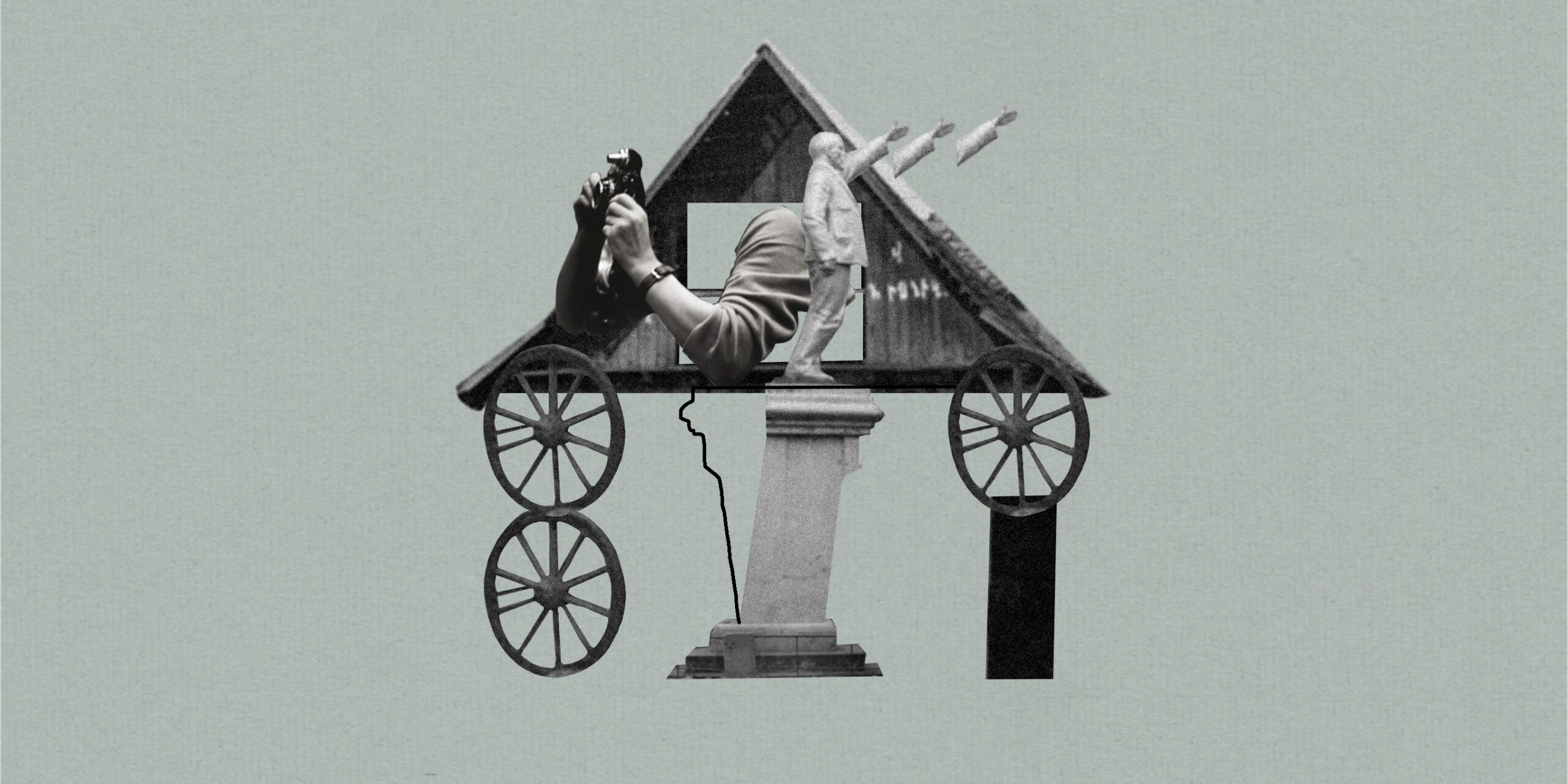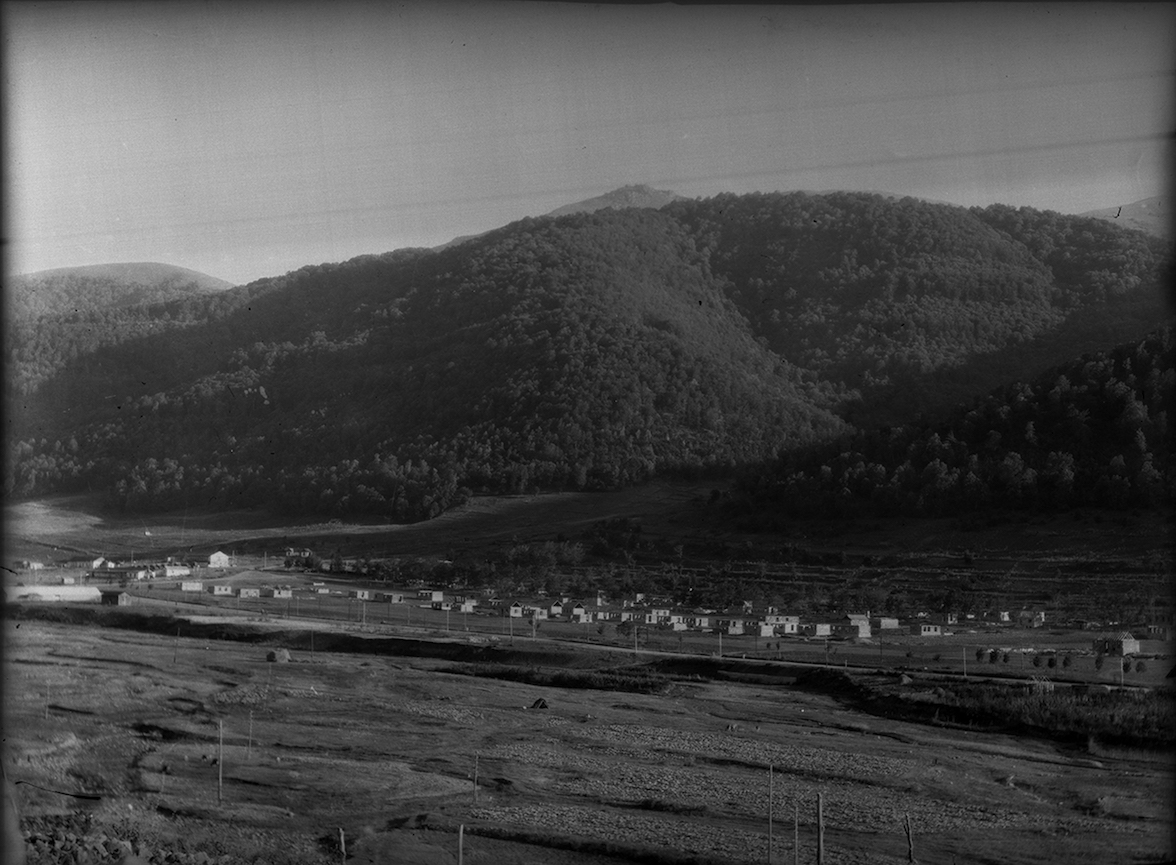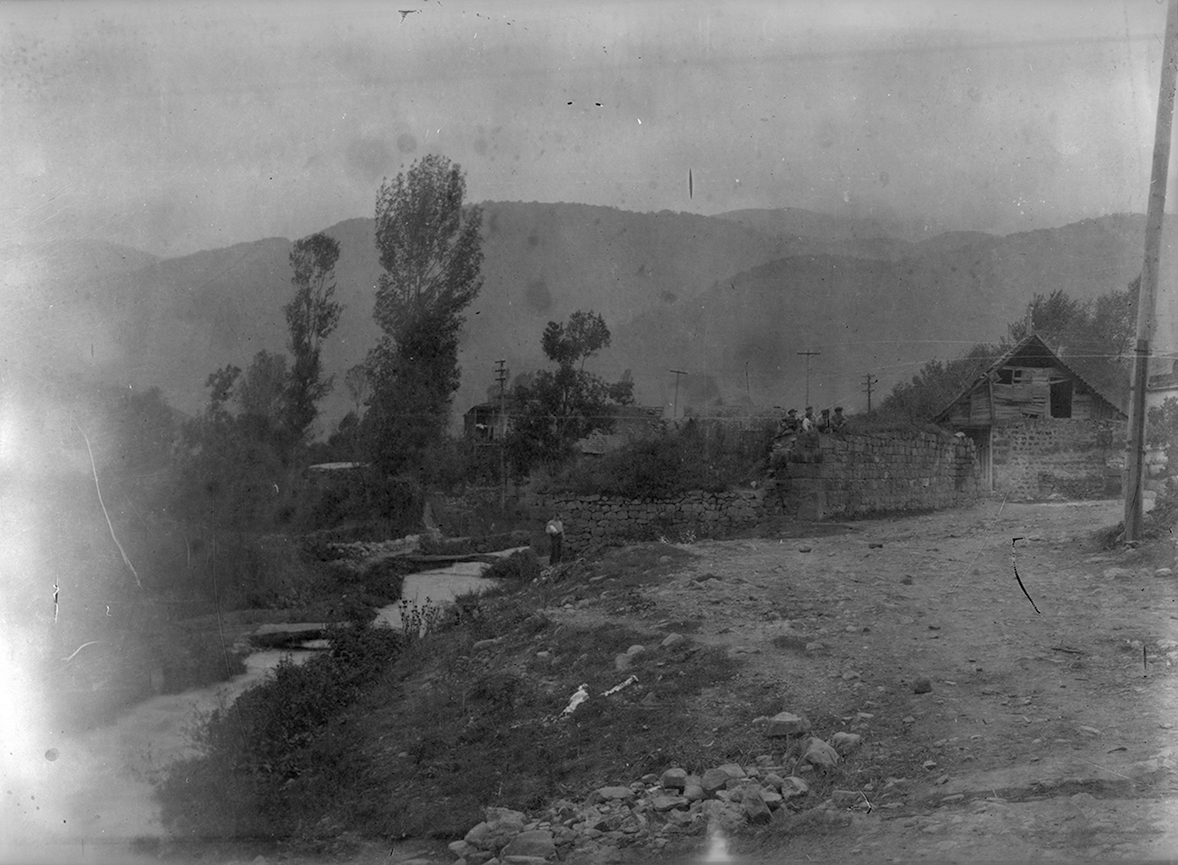
Illustration by Armine Shahbazyan.
When the 1988 earthquake hit the city of Kirovakan (present-day Vanadzor)—Soviet Armenia’s third largest urban center—it destroyed not only hundreds of lives, numerous buildings and infrastructures. The quake also wiped out countless precious memories preserved in the apartments, backyards, communities, collective rituals and customs of this venerable city. In just a flash, the entire industrial sector, which drove Kirovakan’s complex social ecosystem, collapsed into a pile of melancholic ruins. For later generations these fragments of a once vibrant cultural and industrial center could only come alive in and through oral histories and photographs. But the earthquake had irrevocably stolen even that possibility, as numerous private and state archives perished in the ruins or were dispersed in the chaotic post-earthquake aftermath.
One of the most significant of these collections was held by the city’s first official photography studio established by Hamo Kharatyan around 1934. The apartment building where the studio was located was seriously damaged in 1988 and a flood from the burst piping destroyed Kharatyan’s negative archive assembled during the five decades of his practice. The only remnant of the photographer’s extensive output – aside from portraits surviving in the family albums of Vanadzor’s residents – was a roll of large-format cellulose-based negatives that has been preserved by Kharatyan’s heirs as a family heirloom.
Earlier this year, Kharatyan’s granddaughter, Ruzanna Kharatyan, contacted me with the request to have these negatives scanned, since no one in the family seemed to know what they actually contained. Though worn over time, the tightly rolled bundle of negatives slowly began to reveal astonishing, quite unfamiliar aspects of Vanadzor’s life that were already on the verge of disappearing when Kharatyan took these photographs at the onset of his career in the mid 1930s. Less than 20 in number, the black and white images painted a picture of a settlement that was yet to transform from a sleepy mountainous enclave called Karakilisa into one of the giants of the chemical industry in the USSR.
Photographs courtesy of Ruzanna Kharatyan, Vanadzor.
Unofficial in nature, these inconspicuous street photographs caught telling details of the way Stalin’s socio-economic policies were on the cusp of fundamentally altering the pastoral lifestyle of Vanadzor’s residents, whose existence had been inextricably intertwined with the as yet unspoiled green expanses of the region’s land. At times, the views captured by the photographer seem so remote and provincial that his presence itself appears like a dramatic and alien intervention in this otherwise bucolic environment.
Kharatyan’s own journey to Vanadzor was full of twists and turns. Fleeing the increasingly intolerant, anti-Armenian atmosphere of Sultan Abdüll-Hamid’s Ottoman Empire, his family had arrived here from Erzrum in 1887, after a temporary stay in Tiflis. At the time of his birth in 1904, the place was just a cluster of small houses, farms and holiday residencies that belonged to the upper-middle class Armenians who liked to spend their summers in the lush forests surrounding Vanadzor. The construction of the Tiflis-Karakilisa-Alexandrapol railway line in 1899 had somewhat boosted the fortunes of the town, but for an aspiring young man, there was little that the town could offer in terms of education or career prospects. Soon after Armenia’s Sovietization, Hamo was sent to Tiflis where he had bigger prospects for learning a trade.
Karakilisa did not have photo studios in the Czarist era and it is not clear how Kharatyan became interested in photography. But the need for photographic documentation grew exponentially during the first decade of Soviet rule, and the abundance of Armenian studio owners in Tiflis gave plenty of opportunity to learn the craft – a relatively ‘lucrative’ occupation even under communism. According to family lore his master in Tiflis was a famous photographer named Aram (possibly Aram Vruyr), whom Hamo apprenticed while also gaining skills as a shoemaker.
Upon his return to Karakilisa in 1934—soon to be renamed Kirovakan—Kharatyan managed to establish his own studio in the family house, located in the center of the city, next to the Abelyan Dramatic Theatre and the House of the Officers. For the next four decades, Kharatyan served both of these establishments, making portraits of the Theatre’s actors, documenting performances and shooting countless portraits of servicemen and their families. His establishment was the go-to spot for commemorating all important occasions in the lives of the locals, and even with the proliferation of other photo studios in Kirovakan during the 1950s-60s, Kharatyan’s atelier remained preeminent.
What set Kharatyan apart from many other commercial photo-studio operators in Soviet Armenia was his private documentation of street life in his hometown. He was a quiet observer during town festivities, official ceremonies and other public events, unburdened by the pressures of government-sanctioned photo-reportage work and free to peruse reality in all of its complexity. The surviving cachet of Kharatyan’s street images from the mid 1930s vividly present this unassuming gaze that immortalized Vanadzor prior to its metamorphosis into an industrial juggernaut.
Standing at a distance, Kharatyan used his large-format camera to photograph expansive scenes that are topographical in nature. The centrally-balanced, head-on compositions lack any pretense of artistry and appear as almost mechanical surveys of time and place. Poised somewhere between late-19th century ‘view’ photography and the early documentary photography of the 1900s, these images cautiously slide towards objective observation – a dangerous position to take within the Soviet system. That may sound strange today, as Kharatyan’s photographs do not possess any outwardly ‘critical’ elements. But the image of barefooted children dressed in rugs, slumming around on dirt roads surrounded by crumbling houses, already speaks volumes about the impoverished conditions of life in 1930s Armenia that the Soviet propaganda machine tried to veil at all cost. In another shot, the gleaming statue of Lenin (long since destroyed) is photographed in profile, making the leaning figure of the gesticulating leader appear as if it is about to fall down under its own bulbous weight.
Other photographs offer even less, but on sustained contemplation, certain details emerge with striking power as revelations about disappeared and forgotten realities: the hybrid, cross-cultural architecture of those strange houses that no longer exist in present-day Vanadzor, the complete absence of rubbish on the unpaved streets, the relief of Lenin-Stalin duo gracing the facade of dispossessed Armenian wine magnate Tairov’s summer residence, the naive calmness of the locals oblivious of the Stalinist terrors that would befall them in just a couple of years’ time… These subtle anomalies are the ghostly ripples of an old world quickly sinking into the past, captured by a photographer who stands witness to this submergence and the emergence of a new, drastic era.
In this sense, the secret engine inside Kharatyan’s photographs—the hidden ‘prick’ that the great French theorist Roland Barthes called the photographic ‘punctum’—is the very banal and seemingly insignificant material that his camera records by simply being directed at life without a premediated ideological agenda. On a superficial level, these photographs can be considered a straightforward document of a city on the cusp of radical transformations. And yet, what makes these images so piercing is their function as an act of subjective memorialization that weaves a personal narrative of time and place on the margins of official histories. Such photographic narratives become invaluable maps that help us chart more multilayered perspectives onto our recent past – a task of immense urgency in light of the extreme politicization of collective, national and regional histories in the present.
Kharatyan continued to take photographs up until 1982, when he passed away soon after suffering a fatal stroke. His daughter, Larisa, had become her father’s assistant and took over the studio operation after Kharatyan’s death. After their ancestral home was demolished in the redevelopment of Vanadzor’s city center—like all the quaint, thatched-roof houses featured in Kharatyan’s 1930s photographs—the studio relocated to the ground floor of their new apartment building, together with Kharatyan’s archive. Following the 1988 earthquake and the appearance of the first automated Kodak photo-printing machines, Larisa closed the business for good on the eve of Armenia’s independence from the USSR.














